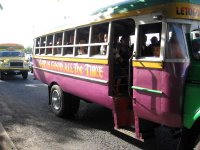 The buses in Samoa are fantastic. A throwback to the old school buses of the United States they make a big impression as you wander the streets of Samoa. There are a small number of companies that operate most of the buses, most notably Queen Poto Transport (pictured here) though many of the operators are individuals, running what may be the single bus that runs to their village.
The buses in Samoa are fantastic. A throwback to the old school buses of the United States they make a big impression as you wander the streets of Samoa. There are a small number of companies that operate most of the buses, most notably Queen Poto Transport (pictured here) though many of the operators are individuals, running what may be the single bus that runs to their village. Whilst the companies like Queen Poto make sure their buses are identical in look, most of the buses feature highly individual designs. Of course I've managed to miss most of these whenever I've had my camera in hand, so the best example I can offer is one of the buses that run to the village of Letogo - the "God Is Good All The Time" bus. Other notable buses include "Queensland - Samoa" and "Poetry in Motion" but my favourite would have to be the "Don't Tell Mum" bus. Apparently the driver's selection in music was so good that schoolkids would stay on the bus instead of getting off and going to school. Their catchcry, "don't tell mum!", now adorns the side of the bus.
Whilst the companies like Queen Poto make sure their buses are identical in look, most of the buses feature highly individual designs. Of course I've managed to miss most of these whenever I've had my camera in hand, so the best example I can offer is one of the buses that run to the village of Letogo - the "God Is Good All The Time" bus. Other notable buses include "Queensland - Samoa" and "Poetry in Motion" but my favourite would have to be the "Don't Tell Mum" bus. Apparently the driver's selection in music was so good that schoolkids would stay on the bus instead of getting off and going to school. Their catchcry, "don't tell mum!", now adorns the side of the bus.The music on the bus is just as important as the way it looks. The buses here are loud. Very loud. I'm able to leave my house at the very last minute in the morning because I can hear the bus coming from a good 200 metres away. If I'm half asleep when you get on the bus, I'll definitely be awake by the time I get off it. The selection is predominantly Samoan but a fair whack of hip hop/r'n'b gets played. Bob Marley is also a favourite.
 So what does the interior of a typical bus look like? They're spartan affairs. Hard wooden benches that seat two people line the sides of the bus. Apart from the odd dashboard adornment (see the koala clipped to the top of rear vision mirror?) and the mandatory oversized speakers at the front and rear of the bus, that's about it.
So what does the interior of a typical bus look like? They're spartan affairs. Hard wooden benches that seat two people line the sides of the bus. Apart from the odd dashboard adornment (see the koala clipped to the top of rear vision mirror?) and the mandatory oversized speakers at the front and rear of the bus, that's about it.Seating arrangements are very particular on the buses here. There are a raft of unspoken rules that govern who sits where. Typically, women and children tend to sit towards the front of the bus, the men towards the back but as the bus fills up with people, a cramped version of musical chairs gets underway. If an older man or woman, or a person with a young child gets on the bus, one of the younger passengers will instantly offer their seat and move towards the back of the bus. This will continue until there are no spare seats left. Things get fun from that point on.
To deal with the lack of seats people will simply sit on the laps of other passengers. In this way, seats that are designed to hold two people end up holding four. People will also stoop in the aisle (the roof is very low) once things really start to get busy.

My village isn't that far out of town so my bus tends not to get too full but a bus trip to the village of Manono-tai (some 40km out of Apia) felt like an unofficial attempt to break a Guinness world record. It was Friday afternoon in peak hour, so there were lots of people heading home for the weekend. Every seat held at least four people. The aisle was full of people, plantains, taro and other essential supplies. It was madness!
Every visitor to Samoa must catch a bus at least once. It's an extraordinary experience and one that is very Samoan. Your bum might be a bit sore from the seat, your ears might ring a little from the loud music but I guarantee you'll hop off the bus with a smile on your face.
No comments:
Post a Comment